Metal Injection Molding
Request a Quote
Quick Metal Injection Molding Links
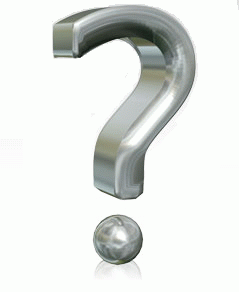
- What Is Metal Injection Molding
- Benefits of the Metal Injection Molding Process
- Limitations of the Metal Injection Molding Process
- Why Choose Jiangsu Tech Specialities For Your MIM Project
- Typical Metal Injection Molding Applications
- Metal Injection Molding Guidelines
- Available Metal Injection Molding Materials
- Overview of the Metal Injection Molding Process
What is Metal Injection Molding?
Metal Injection Molding (MIM) combines the technologies of thermoplastic injection molding and powder metallurgy to produce complex-shaped, high density, high performance metal parts. Best applied to small parts (typically less than 100 grams), the MIM process offers lower cost solutions for numerous applications compared to machining or investment casting, and improved mechanical properties compared to plastic injection molding or zinc die casting.
Since the commercial beginnings of the Metal Injection Molding Process in the mid-1970’s, the technology has matured and gained acceptance in numerous industries, including Automotive Systems, Medical and Dental Instruments, Orthodontics, Firearms, Hardware and Lock Components, and Computer and Electrical applications.
Benefits of the Metal Injection Molding Process
The benefits of the Metal Injection Molding process are best realized by considering the Metal Injection Molding manufacturing process during the initial design stage of the parts or assembly. The primary benefits include:
- Design Freedom - MIM offers design flexibility similar to plastic injection molding. Geometrically complex parts that cannot be produced using the conventional powder metal processes without secondary machining are possible using the MIM process.
- Enhanced Details - MIM provides intricate features such as dovetails, slots, undercuts, threads, and complex curved surfaces. MIM can produce cylindrical parts with greater length-to-diameter ratios.
- Reduced Assemblies – The MIM process can be used to combine two or more simpler shapes into a single, more complex component to minimize assembly costs.
- Reduced Waste/Machining - MIM's capability to provide net shape components eliminates many secondary machining operations.
- Improved Properties - MIM parts are typically 95% to 98% dense, approaching wrought material properties. MIM parts achieve greater strength, better corrosion resistance, and improved magnetic properties when compared to conventional powder metallurgy processes.
Customers requiring mechanical properties exceeding those available with plastic injection molded or die cast materials are turning to MIM. Metal Injection Molding also provides a cost-effective, automated alternative to the labor-intensive investment casting process. With highly complex geometries available, MIM is an effective alternative to complex machined components or intricate assemblies.
Metal Injection Molding excels at producing small, complex components that require thin, uniform cross sections (up to .250 inch). Thicker sections are typically limited by the high cost of the raw material, the difficulties involved in molding defect-free thick sections, and the ability to remove the binders effectively from the molded parts.
The economics of the MIM process favors higher annual part volumes. Although MIM can be a cost-effective solution for small, complex parts at lower volumes, the cost of molding tools discourages lower volume applications.
Limitations of the Metal Injection Molding Process
- Size – The economical part size is typically limited to less than 100 grams due to the cost of the fine metal powders used for MIM parts.
- Section Thickness – The maximum section thickness is generally kept to less than 0.25 inch to effectively remove the thermoplastic binder from the part without damage, and to control distortion during sintering,
- Tolerances – Typically +/- 0.5 percent, down to +/- 0.001 inch (0.025 mm) for very small dimensions. Tighter tolerances require secondary machining or grinding operations.
- Production Volume – Tooling costs generally limit the economic annual production volume to greater than 10,000 parts (with exceptions for very expensive parts).
Why Jiangsu Tech?
- Stainless Steel - Leaders in Powder Metal stainless steel manufacturing.
- Sintering Capability – Vacuum, Ceramic Belt, and Pusher style furnaces for high temperature batch and continuous sintering.
- Quality Systems – Experienced, high volume automotive industry supplier with ISO 9000 certifications.
Metal Injection Molding Applications
- Automotive Systems - Steering Columns (actuators, ignition lock components), Sun Roofs (stop cams), Seating Mechanisms, Solenoids, Fuel Injectors
- Orthodontics – Brackets, Buccal Tubes
- Medical and Dental Instruments – Endoscopic Surgical Instruments
- Firearm Components – Triggers, Sights, Safeties, Seer Blocks
- Ordnance – Guidance Fins
- Hardware and Lock Parts – Lock Cylinders, Bolts, and Sidebars
- Computers and Electronics – Disk Drive Components
- Electrical – Connectors, Switches
Metal Injection Molding Design Guidelines
- Size – The economical part size is typically limited to less than 100 grams due to the cost of the fine metal powders used for MIM parts. Typically 1 to 20 micrometers in diameter (5 to 10 times smaller in diameter than those used for conventional powder metal parts), these fine metal powders are necessary to drive the shrinkage needed to densify the parts during sintering.
- Section Thickness – The maximum section thickness is generally kept to less than 0.25 inch to remove the thermoplastic binder effectively without causing internal damage to the part. Uniformity of section thickness throughout the part aids in preventing cracks, sink marks, and distortion during sintering,
- Details - MIM can accommodate intricate design features such as dovetails, slots, undercuts, threads, and complex curved surfaces.
- Length-to-Diameter Ratio - MIM can produce cylindrical parts with greater length-to-diameter ratios compared to conventional powder metal processing.
- Fixturing – The availability of a surface somewhere on the part that can support the part through the debinding and sintering operations without special fixturing simplifies the process and positively affects the economics of the part.
Metal Injection Molding Materials Available from Jiangsu Tech
- Stainless Steels - 304L, 316L, Duplex, 17-4PH, 430L, 440C
- Low Alloy Steels – Iron-Nickel (Fe-2Ni), 4600
- Soft Magnetic Alloys – Iron, Iron-Silicon (Fe-3Si) Electrical Steel, Iron-Nickel (50Ni-50Fe)
- Low Thermal Expansion Alloys - F15, Alloy 36, Alloy 42
- Custom Blends
Metal Injection Molding (MIM) Process
The Metal Injection Molding process is a multi-stage process that converts fine metal powders into near full density, high strength metal components. MIM competes with cast, wrought, and machined metal components on the basis of both manufacturing cost effectiveness and material properties. The process consists of mixing fine metal powders with thermoplastic binders to form a feedstock which is injection molded into a closed mold. After ejection from the mold, the thermoplastic “binders” are chemically or thermally removed from the part so that the part can be sintered to high density. During the sintering process, the individual particles metallurgically bond together as material diffusion occurs to remove most of the porosity left by the removal of the binder. The sintering process shrinks the part, providing a net shape that can be used as-is or further worked to add additional features or improve tolerances.
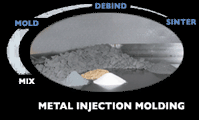 Mixing
Mixing
Metal Injection Molding feedstock begins with micron-sized metal particles. The metal powders are hot mixed with thermoplastics chosen to provide the necessary rheological properties for molding, mechanical properties for handling, and chemical and physical properties for ease of subsequent binder removal. Good feedstock formulations balance numerous conflicting cost and processing factors relating to both powder and binder selection.
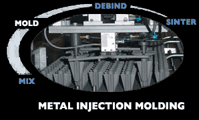 Molding
Molding
Standard plastic injection molding machines are used to form Metal Injection Molding components. The feedstock is heated in the barrel to soften the powder/binder feedstock to a toothpaste consistency. This hot paste is injected into a closed mold cavity and cooled prior to ejection. Robotic pick-off is typically used to prevent handling damage. Runners and gates are reground and reused, minimizing scrap loss at the molding operation.
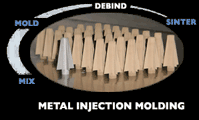 Debinding
Debinding
Once the part is molded, the thermoplastic binders used to help the powder flow into the die are no longer needed and must be removed. First, a portion of the binder is removed to open up a pore network within the part. The remaining binder is subsequently removed through the open pore network that has been created. This two-stage process removes the binder without creating internal cracks or voids within the part. There are several effective binder removal methods in commercial practice, both thermal and chemical, each with its own set of advantages and limitations.
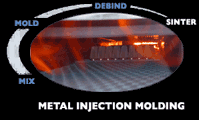 Sintering
Sintering
After the binder is removed, the parts are heated in a protective atmosphere to a temperature high enough to create metallurgical bonds between the powder particles and cause densification. This process typically relies on solid state diffusion and/or liquid phase formation to drive the densification process. The parts typically shrink 15 to 20 percent from the original die size during sintering to achieve final component density of 96 to 98 percent of full density. Optimum sintering temperature depends on the material, typically 2200°F to 2550°F (1200°C to 1400°C) for ferrous materials.